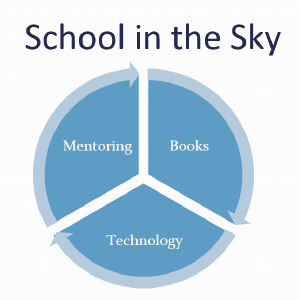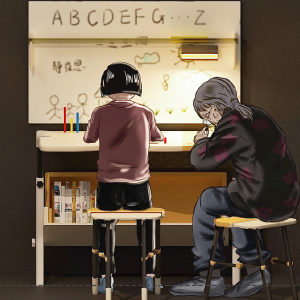Stanford Center on Longevity Announces “Closing the Inequity Gap: Designing for Affordability” Design Challenge Winners
April 7, 2020, Stanford, CA
After the first ever online Longevity Design Challenge Finals, the Stanford Center on Longevity has named Shishu, Sui aur Dhaaga the winner of the 2019-2020 Design Challenge competition. This team beat out 159 other entries from 35 countries over the course of the competition to win the $10,000 grand prize.
The Shishu, Sui aur Dhaaga team from the Srishti Institute of Art, Design and Technology in India presented their design for a bracelet that converts a common local cultural practice into an immunization tracker for infants.
The second place prize was awarded to the School in the Sky team from Brigham Young University in Utah, USA. School in the Sky is a cloud-computing based education system for very poor areas that links U.S. students and retirees as mentors and teachers.
The third place winner was The First Desk team from Beijing Institute of Technology, China. The First Desk is an extremely low cost education station for rural youth and their grandparents.
The 2020 Design Challenge theme encouraged students to identify and design for opportunities to significantly reduce the cost of innovations that help people at all ages increase their odds of long and healthy life outcomes. The latest innovations are often unavailable to people at the lower levels of socioeconomic status, an issue that has become more pressing as the world copes with the COVID-19 pandemic.
To prevent the spread of the virus, all in-person finals events were cancelled and the entirety of the final competition was held online. The majority of the finalists’ universities closed their doors in the midst of the finalists working on their final presentations, and the teams had to complete their designs at a distance from each other. The finalists produced incredible work in the face of these hurdles.
“It’s been a remarkable experience communicating with these teams throughout the crisis. They have all shown a great deal of tenacity and creativity, even as their familiar systems have changed all around them. It’s exciting to know these are the designers of our future,” noted Marie Conley Smith, Social Science Research Professional at the Center, who was responsible for coordinating the teams.
The finalists all received a $1000 prototyping award, as well as an additional $1000 per team as a consolation prize for having been unable experience Stanford and the Finals in person. They were also provided with online materials from the Stanford Graduate School of Business and additional mentorship to learn how to take their product or service to market. The entire competition is industry-sponsored and free to enter, enabling students from all circumstances to participate.
“This year was truly a unique situation, and I was impressed by how everyone came together to complete a successful Challenge and recognize the great work done over the course of the year by our finalists,” commented Professor Laura Carstensen, Founding Director of the Stanford Center on Longevity. “I want to thank the teams and our sponsors for their flexibility and congratulate all of the finalists for their accomplishments, and of course, I am enormously grateful to Ken Smith and Marie Conley Smith for their continued efforts to lead the Challenge.”
Here’s a closer look at this year’s winners and finalists:
FIRST PLACE
Shishu, Sui aur Dhaaga
Srishti Institute of Art, Design and Technology, India
 Translates from Hindi to “Baby, Injection, and Thread.” A bracelet that converts a common local cultural practice into an immunization tracker for infants.
Translates from Hindi to “Baby, Injection, and Thread.” A bracelet that converts a common local cultural practice into an immunization tracker for infants.
SECOND PLACE
School in the Sky
Brigham Young University, USA

A cloud-computing based education system for very poor areas that links to U.S. students and retirees as mentors and teachers.
THIRD PLACE
The First Desk
Beijing Institute of Technology, China

An extremely low cost education station for rural youth and their grandparents.
FINALISTS
Affordable Solar Cooling and Filtration Technology (Pan-African University, Algeria) – A solar powered refrigerator and filtration system intended to preserve food longer and reduce food-borne illnesses.
Den Mail (San Francisco State, USA) – A system for providing permanent mailing addresses to the homeless population.
The First Desk (Beijing Institute of Technology, China) – An extremely low cost education station for rural youth and their older relatives.
Rural Auxiliary Equipment Pit Latrine (Beijing Institute of Technology, China) – A solution to reduce falls and increase accessibility of stand-up toilets.
Prothoma (Bangladesh University of Professionals, Bangladesh) – A re-usable anti-microbial sanitary napkin.
School in the Sky (Brigham Young University, USA) – A cloud-computing based education system for very poor areas that links to U.S. students and retirees as mentors and teachers.
Shishu, Sui aur Dhaaga (Srishti Institute of Art, Design and Technology, India) – Translates from Hindi to “Baby, Injection, and Thread.” A bracelet that converts a common local cultural practice into an immunization tracker for infants.
VepoX (Makerere University, Uganda) – A water filtration solution using locally sourced materials.
FINALS JUDGES
 Staci Alexander
Staci Alexander
Director, Thought Leadership-Outreach, Office of Policy, Research & International Affairs, AARP
 Elena Carrasco
Elena Carrasco
Research Engineer II, Advanced Research, USAA Labs
 Sara Garvey
Sara Garvey
Research Program Manager, Davis Phinney Foundation
 Alan Goldstein
Alan Goldstein
Managing Director, P&G Ventures
 Sumita Jonak
Sumita Jonak
Strategic Innovation Director & Lead Research Engineer, USAA
 Todd Murch
Todd Murch
President & CEO, Eskaton
 Jane Nakagawa
Jane Nakagawa
Division Director, Future Mobility & Solutions, Honda R&D Americas
About the Design Challenge
The Stanford Center on Longevity Design Challenge is a global competition aimed at encouraging students to design products and services to improve the lives of people across all ages. Established in 2013, the Challenge is focused on ways to motivate and empower people in their daily lives both inside their homes and in their community, particularly as they remain healthy and vigorous long past the traditional beginning of retirement.
For more information, visit http://designchallenge.stanford.edu
The challenge is made possible by generous sponsorship from a number of companies and foundations. Lead sponsorship is provided by Target, Honda R&D Americas, Inc., and USAA. Additional financial support has been provided by Procter & Gamble, Stoneridge Creek, Davis Phinney Foundation, Eskaton, AARP, Fidelity, and Mercer.
About the Stanford Center on Longevity
The mission of the Stanford Center on Longevity is to redesign long life. The Center promotes the acceleration and implementation of scientific discoveries, technological advances, behavioral practices, and social norms so that century long lives are healthy and rewarding. Founded in 2007 by Laura Carstensen, PhD and Thomas Rando MD, PhD, the Center works with more than 150 Stanford faculty, their students and research staffs, as well as leaders from industries, thought leaders, and policy makers to develop workable solutions for urgent issues confronting the world as the population ages. For more information, visit https://longevity.stanford.edu
